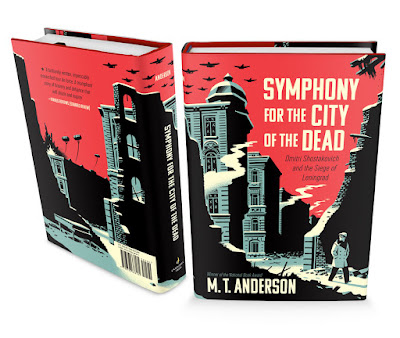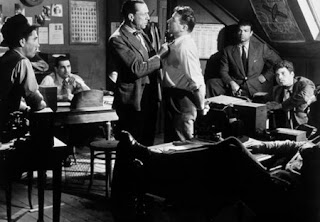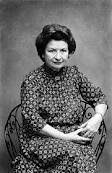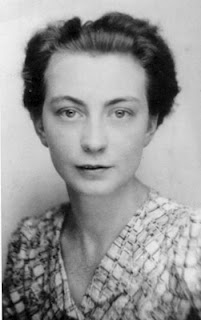Life out of the City of the Dead
For the last week I've been eating, sleeping, and talking nearly incessantly about Shostakovich and the Siege of Leningrad. What prompted this? M.T. Anderson's wonderful book Symphony for the City of the Dead. The volume arrived in the library I work in, and as soon as I saw it, with its fabulous cover artwork by Kikuo Johnson, I knew I wanted to read it, not least because I like Shostakovich and have a long standing interest in Second World War history.
The book however turned out to be very different from what I was expecting. It really was quite a journey...
M.T. Anderson is an American writer, who's best known as an author of children's books - everything from picture books to novels for young adults. Rather to my surprise (not knowing of M.T. Anderson's background), Symphony for the City of the Dead was aimed at the young adult market. If you're not a young adult any more, please don't be put off by this, as I think that oddly enough this made the book all the more powerful. This isn't an academic treatise, you don't need to know anything about music, or twentieth-century history. The simplicity of Anderson's story-telling, his juxtaposition of light and shade are breath-taking. This was one of the most gripping books I've ever read - an astonishing story, which happens to be true.
Symphony for the City of the Dead tells the story of Shostakovich's life in the Soviet Union, focusing particularly on his 7th Symphony, and the siege that inspired it.
Brought up in a middle class household in the centre of Russian culture, St. Petersburg, Shostakovich grew up in the turmoil of the revolution. A musical genius, he fell foul of Stalin's regime. Anderson's story commences well before the Second World War with the early days of Shostakovich and the pre-war relationship of Russia and Germany. There are some blackly comic moments as Anderson examines this period. For example, the Tintinesque tale of Stalin's attempt to frame a General that he wished to depose. The NKVD (forerunners of the KGB) approached a double agent, who they knew was also in the pay of the German Secret Service, and asked him to ask the Nazis if they would forge letters implicating the innocent Russian General as a German spy. The Nazis were eager to help out (anything that was likely to undermine the Soviet Army was fine by them), however the Russians distrusted the double agent. Anderson explains "they ordered two spies to stake [him out]; one named Ivan, Son of Pantalei, and the other, Pantalei, Son of Ivan. One wore a monocle. They usually worked as sandwich-board men, stumping up and down the boulevards of Paris wearing giant signs advertising cheap dinners..." The Nazis provided forged letters, the Soviets paid for them with forged money. And yet even this comical scene is juxtaposed against the death of an innocent, loyal man. The topsy-turvey world of a state in the grip of a brutal dictator has rarely been portrayed so well.
Anderson assumes that his reader may know little of the background of Shostakovich or the history in which his life played its part, so, without a hint of patronising the reader, and without going into great detail, Anderson gently reminds us that we can never be entirely sure of the authenticity of many accounts of those who survived the horror of Stalin's Russia. The Alice in Wonderland quality of this peculiar state has seldom been clearer, except perhaps in Bulgakov's Master and Margarita (it is clearly no coincidence that Bulgakov was a friend of Shostakovich).
Following the Nazi invasion of Russia life became worse for the citizens of the Soviet Union. Hitler ruthlessly calculated that he didn't need to spend money on armaments to bring St. Petersburg, now Leningrad, to its knees. Using a team of nutritional experts he calculated that the city could be starved to death, and set out quite deliberately to do so. The people of Leningrad died en masse - in their homes, on the street, at work. The bitter Russian winter meant that it was difficult to bury the dead, the weakness of the living made it impossible. As the siege continued, bodies littered the streets.
There were some wonderful stories of courage, there were also horrible events, which showed how hunger and brutality could turn men to something less than animals. Anderson never shies away from this, and the simplicity of his language makes it all the more arresting - "A mother whose child disappeared went to the police. They directed her into a room filled with crates of clothing marked by number. They told her to search for her child's clothes. When she found the clothing, she could report the number on the crate to the police and they would tell her the district where her child was eaten".
Against this background, Shostakovich composed perhaps his most enduring work, the 7th Symphony, the "Leningrad" symphony. A paean of praise to his native city and its citizens, the symphony won a propaganda war in the United States (the video above is the Toscanini recording, that was the first broadcast of Shostakovich 7 in the States). It made the Leningraders proud of the spirit of their city, it made them feel that perhaps they were going to win after all; and for the German troops nearby, it sowed the first seeds of uncertainty - how could these subhumans write music like this? How could they play it so vibrantly and lovingly in the jaws of starvation?
Allied with this is the story of how the symphony itself made its way to the West. From error strewn, hand written score and parts to a microfilm that crossed the Near East, paid a visit to Brazil, and almost ended up in the garbage can of a fast food eatery, it's an inspiring true story of the power of the human spirit. As was evident in Agnes Humbert's Resistance, war shows the worst and the best in humanity. Seldom has it been described so well as it is in M.T. Anderson's Symphony for the city of the dead. It's a wonderful book.
The book however turned out to be very different from what I was expecting. It really was quite a journey...
M.T. Anderson is an American writer, who's best known as an author of children's books - everything from picture books to novels for young adults. Rather to my surprise (not knowing of M.T. Anderson's background), Symphony for the City of the Dead was aimed at the young adult market. If you're not a young adult any more, please don't be put off by this, as I think that oddly enough this made the book all the more powerful. This isn't an academic treatise, you don't need to know anything about music, or twentieth-century history. The simplicity of Anderson's story-telling, his juxtaposition of light and shade are breath-taking. This was one of the most gripping books I've ever read - an astonishing story, which happens to be true.
Symphony for the City of the Dead tells the story of Shostakovich's life in the Soviet Union, focusing particularly on his 7th Symphony, and the siege that inspired it.
Brought up in a middle class household in the centre of Russian culture, St. Petersburg, Shostakovich grew up in the turmoil of the revolution. A musical genius, he fell foul of Stalin's regime. Anderson's story commences well before the Second World War with the early days of Shostakovich and the pre-war relationship of Russia and Germany. There are some blackly comic moments as Anderson examines this period. For example, the Tintinesque tale of Stalin's attempt to frame a General that he wished to depose. The NKVD (forerunners of the KGB) approached a double agent, who they knew was also in the pay of the German Secret Service, and asked him to ask the Nazis if they would forge letters implicating the innocent Russian General as a German spy. The Nazis were eager to help out (anything that was likely to undermine the Soviet Army was fine by them), however the Russians distrusted the double agent. Anderson explains "they ordered two spies to stake [him out]; one named Ivan, Son of Pantalei, and the other, Pantalei, Son of Ivan. One wore a monocle. They usually worked as sandwich-board men, stumping up and down the boulevards of Paris wearing giant signs advertising cheap dinners..." The Nazis provided forged letters, the Soviets paid for them with forged money. And yet even this comical scene is juxtaposed against the death of an innocent, loyal man. The topsy-turvey world of a state in the grip of a brutal dictator has rarely been portrayed so well.
Anderson assumes that his reader may know little of the background of Shostakovich or the history in which his life played its part, so, without a hint of patronising the reader, and without going into great detail, Anderson gently reminds us that we can never be entirely sure of the authenticity of many accounts of those who survived the horror of Stalin's Russia. The Alice in Wonderland quality of this peculiar state has seldom been clearer, except perhaps in Bulgakov's Master and Margarita (it is clearly no coincidence that Bulgakov was a friend of Shostakovich).
Following the Nazi invasion of Russia life became worse for the citizens of the Soviet Union. Hitler ruthlessly calculated that he didn't need to spend money on armaments to bring St. Petersburg, now Leningrad, to its knees. Using a team of nutritional experts he calculated that the city could be starved to death, and set out quite deliberately to do so. The people of Leningrad died en masse - in their homes, on the street, at work. The bitter Russian winter meant that it was difficult to bury the dead, the weakness of the living made it impossible. As the siege continued, bodies littered the streets.
There were some wonderful stories of courage, there were also horrible events, which showed how hunger and brutality could turn men to something less than animals. Anderson never shies away from this, and the simplicity of his language makes it all the more arresting - "A mother whose child disappeared went to the police. They directed her into a room filled with crates of clothing marked by number. They told her to search for her child's clothes. When she found the clothing, she could report the number on the crate to the police and they would tell her the district where her child was eaten".
Allied with this is the story of how the symphony itself made its way to the West. From error strewn, hand written score and parts to a microfilm that crossed the Near East, paid a visit to Brazil, and almost ended up in the garbage can of a fast food eatery, it's an inspiring true story of the power of the human spirit. As was evident in Agnes Humbert's Resistance, war shows the worst and the best in humanity. Seldom has it been described so well as it is in M.T. Anderson's Symphony for the city of the dead. It's a wonderful book.










Comments